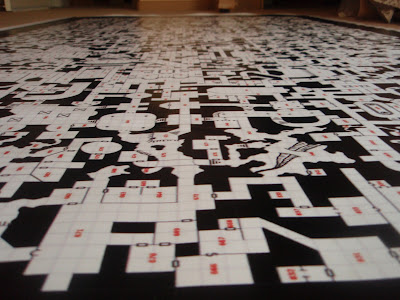Here is a little D&D plot idea that I came up with for a party of first-level adventurers. Feel free to use it for your next gaming session if you want.
This adventure begins in the civilized territory of Westhaven,
which is
marked by five sizable dwellings (Applegate, Darrow, Kielport, Millsend and
Thornberry). The small town of Millsend is located on the river Vinewater, north of Spirit Lake. The inhabitants of Millsend, which include
several hundred families, are predominantly agricultural laborers. Recently,
the town’s tree cutters have reported sightings of strange creatures in the
woods surrounding Spirit
Lake, causing them to abandon
their logging sites. Since Millsend
depends on the regular flow of logs to the other towns to sustain its economy, the
town is in need of someone to investigate the woods and hopefully rid them of
any unwanted visitors.
Spirit
Lake sits at a higher
elevation than the surrounding countryside, resting just above the base of the
mighty Slumbering Hills. Very few people
have ever wandered up into the hills and returned to tell about it. However, the lower region, including Spirit Lake,
has been considered safe until the recent sightings. The lake is virtually surrounded by forest,
with some obvious logging activity creating an opening to the south, where the
Vinewater flows down into the lowlands.
The creatures which have alarmed the loggers are satyrs,
which have come down from the mountains to the south. If any of the loggers is asked for
information about the creatures, their reports will vary from seeing strange
lights or devil-shadows to hearing strange voices or even sweet music. The satyrs are not hostile, but do not wish
any interaction with people. However, it
will be the task of the adventuring party to make contact with the satyrs, and
see if a solution to the logging problem can be reached.
Farther up the hillside, the woods turn faerie in
nature. It’s quite possible that anyone
adventuring up the hills south of Spirit
Lake will encounter other
fey creatures such as pixies, dryads or sprites. However, the players should be discouraged
from adventuring south until they are at a higher level. Encountering the satyrs will reveal that they
have been temporarily exiled from their woods for excessive revelry. The satyrs are not allowed to return (by the
centaurs who exiled them) until they obtain a special magic artifact to prove
their worth. The magic item will have to
be located by the adventurers to rid Spirit
Lake of the satyrs.
The magic artifact that the satyrs require is a red
crystal
ball, which was mischievously taken from the centaurs by a couple of
pixies, and thrown into the waters of Spirit Lake.
Finding the crystal ball would be nearly impossible, but the pixies finally
revealed to the chief centaur that they saw it float down the Vinewater, into
the lowlands. The crystal ball is but one
of a pair that can spy on each other.
So, the person who peers into one crystal ball would be able to peer out
of the second, and vice versa. The
satyrs are in possession of the blue crystal ball, but will not
offer it freely to the adventurers.
Instead, they will ask the party to bring them some fine wine as
compensation for loaning out the blue crystal ball. Once the satyrs have their
wine, they will hand over the blue crystal ball so that the party can use it to
find the other one.
The fine wine can be purchased at various shop locations in
Westhaven, although it would be quite expensive. The wine can also be acquired by thievery, or
from Vinberry Cellars, outside the village
of Thornberry. The Vinberry winemaker will give a few
bottles in exchange for ridding his wine cellar of a few beasties, namely giant
spiders and rats. If the party tries to
give the satyrs cheap wine, they will reject it after inspection (opening the
bottle).
Once the adventurers have the blue crystal ball from the
satyrs, they can peer into it to try to locate the red crystal ball. However, since only the red ball’s
surroundings will be revealed, they will have to piece together clues to
determine its whereabouts.











